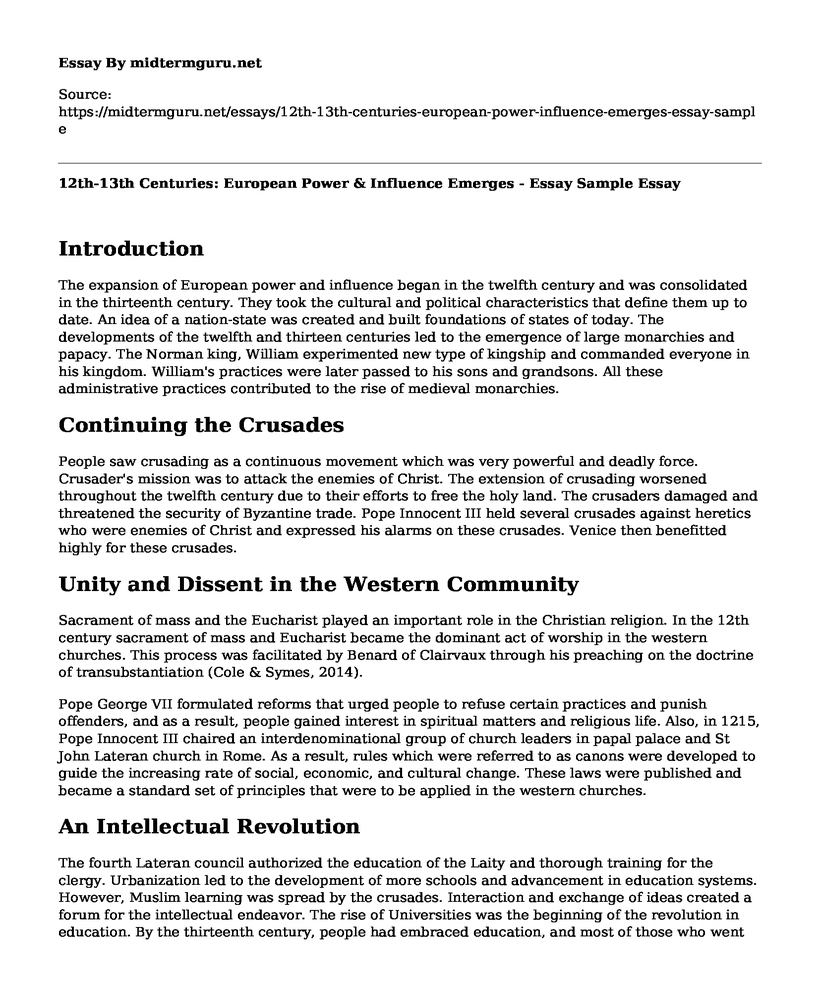Introduction
The expansion of European power and influence began in the twelfth century and was consolidated in the thirteenth century. They took the cultural and political characteristics that define them up to date. An idea of a nation-state was created and built foundations of states of today. The developments of the twelfth and thirteen centuries led to the emergence of large monarchies and papacy. The Norman king, William experimented new type of kingship and commanded everyone in his kingdom. William's practices were later passed to his sons and grandsons. All these administrative practices contributed to the rise of medieval monarchies.
Continuing the Crusades
People saw crusading as a continuous movement which was very powerful and deadly force. Crusader's mission was to attack the enemies of Christ. The extension of crusading worsened throughout the twelfth century due to their efforts to free the holy land. The crusaders damaged and threatened the security of Byzantine trade. Pope Innocent III held several crusades against heretics who were enemies of Christ and expressed his alarms on these crusades. Venice then benefitted highly for these crusades.
Unity and Dissent in the Western Community
Sacrament of mass and the Eucharist played an important role in the Christian religion. In the 12th century sacrament of mass and Eucharist became the dominant act of worship in the western churches. This process was facilitated by Benard of Clairvaux through his preaching on the doctrine of transubstantiation (Cole & Symes, 2014).
Pope George VII formulated reforms that urged people to refuse certain practices and punish offenders, and as a result, people gained interest in spiritual matters and religious life. Also, in 1215, Pope Innocent III chaired an interdenominational group of church leaders in papal palace and St John Lateran church in Rome. As a result, rules which were referred to as canons were developed to guide the increasing rate of social, economic, and cultural change. These laws were published and became a standard set of principles that were to be applied in the western churches.
An Intellectual Revolution
The fourth Lateran council authorized the education of the Laity and thorough training for the clergy. Urbanization led to the development of more schools and advancement in education systems. However, Muslim learning was spread by the crusades. Interaction and exchange of ideas created a forum for the intellectual endeavor. The rise of Universities was the beginning of the revolution in education. By the thirteenth century, people had embraced education, and most of those who went to school were not the clergy. Cathedral schools' curriculum was changed to accommodate both ecclesiastical and local governments with more advanced skills. Formal schooling was always for men, but later, women and girls were highly educated.
Courts, Cities, and Cathedrals
By the eleventh century, the European society had divided into those who prayed, those who worked, and those who fought. The rich members of the society were bankers and merchants, while aristocrats had to interact with them during trade and intermarriages. Warriors and hunters, on the other hand, were a sign of nobility and they protected the community with divisions among these classes of people there developed rules to govern them. As a result, courts developed. The interaction led to the emergence of cities (Cole & Symes, 2014). The growth of papal power influenced the Christians' daily life, therefore, leading to the growth of more cathedrals.
Conclusion
The growth of towns, monarchies, and churches in the medieval period led to increased interest to access in education, new forms of social mobility. Scholasticism was a method of teaching and learning used in medieval schools to debate and resolve problems. More universities grew during the medieval phase hence promoting education during the high middle ages. Students still pursue a degree which was first granted by the medieval universities and wore the gowns of medieval scholars. The urban gothic architecture was used by Renaissance artists as monuments of destruction, but later on, they were manifestations of their pride, symbols of triumphant, and confidence of the church. Example of Gothic architecture was the cathedral dedicated to Virgin Mary at Reims which made cathedral an encyclopedia of medieval knowledge.
Reference
Cole, J., & Symes, C. (2014). Western civilizations: Their history & culture.
Cite this page
12th-13th Centuries: European Power & Influence Emerges - Essay Sample. (2023, Jan 16). Retrieved from https://midtermguru.com/essays/12th-13th-centuries-european-power-influence-emerges-essay-sample
If you are the original author of this essay and no longer wish to have it published on the midtermguru.com website, please click below to request its removal:
- How Process of Writing History Affects Abina and the Important Men
- Paper on History Example: World War I
- Paper Example on Prometheus Bound
- Paper Example on Occupational Therapy: Culturally Diverse Families
- Essay Sample on US Invasion of Iraq in 2003
- Essay Sample on America's Movements and Its Music
- Article Analysis Essay on "Frederick Douglass's Rhetorical Legacy"







